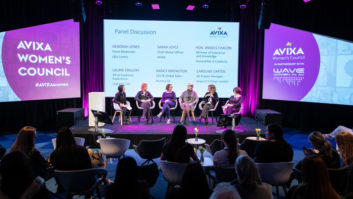
Hi Heidi. What are your views on the subject of gender diversity in the AV industry?
There is a gender gap in the AV industry, but it’s not simply an AV industry gender gap. It reflects a gap across STEM disciplines. And it’s not just an issue in the workforce either. It’s also an issue in academia, where women and girls still don’t pursue technology and engineering-related fields as a career at nearly the same rate as men and boys. In fact, if anything, there are signs that the number of women entering some STEM fields, such as computer science, is dropping. The AV industry needs to be part of the bigger conversation about how to attract more women into the STEM workforce.

ISE saw women make up just 11 per cent of the 80,000+ attendees at the 2018 event. How does this compare with InfoComm?
The percentage of women at the North American InfoComm show is about 15 per cent and has held pretty steady in recent years. But although we’d agree there is a gender gap in the industry, I’d caution against drawing direct conclusions about the size of the gap based on ISE or InfoComm attendance numbers, which reflect only the professionals in positions that attend the shows.
Do you consider the lack of females working in the AV industry to be a problem?
The AV industry is constantly looking for new talent, and to do that it needs to draw from the broadest talent pool possible. But when almost half of the professional workforce isn’t entering technology fields, it presents a problem – for us, for IT, for engineering, for computer science, and others.
Gender diversity can only help the AV industry. There are studies that indicate gender-diverse teams are more innovative, and that gender-diverse management leads to greater company value. If any company in any industry – including the AV industry – fails to seize on those benefits, it’s a problem.
AVIXA is extremely active with hosting AV events and training – are these predominantly male attended?
Our events reflect the industry at large, which is currently majority male.
You’ve [AVIXA] recently increased your focus on training and presenting to end users – what is a typical audience in this instance?
This depends on the market we’re engaging with, and I don’t have exact numbers, but, for example, when we are addressing the retail and hospitality markets, a higher percentage of those audiences are women. In other markets, there may be more of a gender gap.
What about your own staff? How many are female and how many of those are directly involved with the educational aspect?
AVIXA is about 50 per cent female. Importantly, our board of directors is one-third women and our Leadership Search Committee, whose job it is to identify talented AV professionals to serve the industry in AVIXA leadership roles, is almost half women. To be clear, AVIXA’s board and LSC seeks the most qualified individuals to steer our efforts supporting the industry regardless of gender, race, colour, religion, sexual orientation, or disability. We are fortunate for – and both AVIXA and the industry benefit from – the amazing women who serve.
Why do you think there are few females working in the AV industry?
The answers aren’t simple. There are likely many reasons more women don’t enter the AV workforce or any other technology trade, for that matter. According to the US Census Bureau, there continues to be a sizeable gender pay gap in STEM-related jobs. According to Pew Research, half of women in STEM jobs say they’ve been discriminated against
at work. Not to draw a direct correlation to the AV industry, for which I don’t have specific figures, but that’s a problem. So technology-related industries, like all industries, need to take positive steps to ensure that working in those fields is a rewarding, positive experience for all talented professionals, regardless of their gender.
Given AVIXA’s importance to the AV industry, do you feel you have a responsibility to address this issue?
AVIXA encourages and supports efforts toward promoting greater gender diversity. We created what is now the AVIXA Women’s Council several years ago to give women and men a forum for addressing gender diversity and promoting mentorship opportunities.
Is there anything AVIXA is doing, can do, or is planning to do, to address the issue?
For several years, AVIXA worked with organisers of the USA Science & Engineering Festival and related programmes to show young women and men how exciting audio and video can be, and how they can pursue studies – or even a career – in AV.
At the professional level, the AVIXA Women’s Council – including men and women – continues to be one of our most successful and engaging volunteer initiatives to date, with local groups hosting events worldwide to help support and encourage women working in technology industries.
And within the last few weeks, AVIXA has taken the first steps toward establishing a new Diversity Council, which will promote gender diversity as well as diversity of race, colour, religion, sexual orientation, and disability. With the AV industry growing the way it is, and with a tightening labour market of qualified AV professionals, it’s critical that the industry be as inclusive as possible in order to attract talent.
Finally, the AVIXA Foundation, which works closely with the association on workforce development issues, is realigning its strategic priorities to include efforts that actively promote diversity through its programmes, which include scholarships and grants.
www.avixa.org







